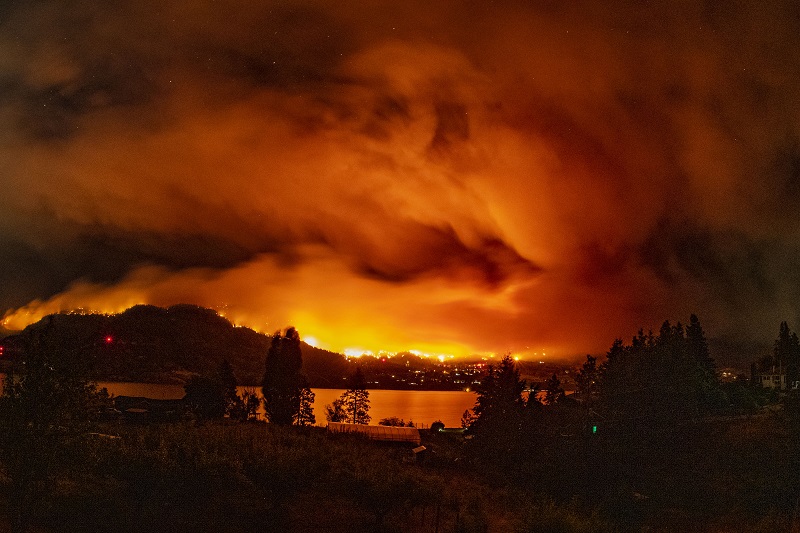Wildfires: Where there’s smoke, there’s damage

As smoke from almost 900 of Canada’s wildfires descends upon the United States, resurrecting media reports about air quality, Canadian property and casualty insurers have an eye on a different type of exposure — property damage claims due to wildfire smoke.
Rob de Pruis, national director of consumer and industry relations at Insurance Bureau of Canada, observed that when the 2016 wildfire devastated the community in Fort McMurray, Alta., the catastrophe generated “thousands” of smoke damage claims from insureds whose properties did not actually burn.
Could the current wildfire smoke cause property damage in nearby communities?
“Absolutely, and that is covered under a standard home or business insurance policy,” de Pruis told Canadian Underwriter in an interview Monday. “If your policy covers fire, it also covers smoke damage that can be a result or a byproduct of nearby wildfires, or even fire to your property where it’s partially damaged.”
The risk of smoke damage is higher for homes built near the wildland/urban interface, since many wildfires can essentially go up to the property lines of many of these homes. Insurers may get claims for smoke damage in homes right on that border.
“That’s where [property] is more heavily impacted [by smoke damage], compared to homes that are more in the middle of an urban setting, where there’s not a lot of fire damage within several blocks or even several kilometres,” de Pruis said.
Wind patterns make a difference, too. “A block or two can make a substantial difference, given the way smoke travels based on the wind. Even though [homes] are only a block away from major fire, if the winds are always blowing away from your home, you’re a lot less likely to have that type of [smoke] damage to your property.”
In Halifax, de Pruis said he witnessed some insurance claims related strictly to smoke damage. “We saw homes that were right on the cusp of a greenbelt, where many trees were burnt,” he recalled. “Even though the home itself may have sustained minimal damage — think of just some siding melting — there could have been some substantial smoke damage inside of that property.”
Smoke damage comes in many forms, and insurers address the need for remediation on an individual basis.
“You don’t know until you can go into the property and take a look at what’s going on,” de Pruis said. “The key is, you need to remove the source [of the damage]. So, if particulate is all over the interior, that property would need a full remediation, versus homes that could have been a couple blocks away. [Homes further away] may [only] need an exterior power wash, for example, depending on what is [burning] around that area, whether it be natural products or whether it is petroleum or other products that can be a bit more damaging.”
Related: Here’s what adjuster capacity is like for Canada’s wildfires
To choose appropriate tools to remediate smoke damage, “you have to think about what exactly smoke is,” said de Pruis. “Smoke is the suspension of carbon or other particles in the air that are typically emitted when something burns.”
Essentially, three types of soot are linked to odours in need of some form of remediation:
Wood, paper products, or other natural materials, when burned, produce soot or residue that is kind of a grayish charcoal to black colour. But it’s dry, so it’s possible that it can be vacuumed up or wiped down. Or perhaps remediated with a HEPA filter.
Protein fires, resulting from burning meat, poultry, or fish, produce a residue that’s sticky or oily with a yellow to brownish colour (akin to residue you might find on the range hood over a stove).
Residues produced by burning synthetics, plastics, petroleum and oil byproducts, are blackish in colour, very oily, and smudge easily. This type of particulate can be very, very small and can get into things like ductwork, or behind some electrical sockets.
Each of these residue types requires specialized training to detect, and require different cleaning tools and products to remediate. Examples of such tools include dry and wet fogging equipment or ozone machines.
Restoration contractors and other claims professionals distinguish themselves with a special certification in cleaning smoke and other damage offered by the Institute of Inspection, Cleaning and Restoration Certification (IICRC). The certification is called ‘FSRT,’ for Fire and Smoke Damage Restoration Technician. Insurers typically work with preferred vendors who have credentialed experts on hand.
De Pruis cautions insureds who might wish to save a buck by not making an insurance claim for smoke damage do so at their own peril. The risk is that insureds may give the remediation job to contractors without specialized knowledge of cleaning smoke damage, and wind up with an inferior and/or ineffective remediation job.
“A lot of insurance companies promote their preferred vendors because they’ve gone through the [accreditation] process [for cleaning smoke damage], as opposed to someone who just knocks on your door to say, ‘Hey, I can clean your home for half the price as the insurance company.’
“They’re likely doing it for half the price because they’re doing less than half of the work. Insurers and their vendors are using the appropriate tools or equipment to do it properly.”
Feature image courtesy of iStock.com/shootthebreeze







